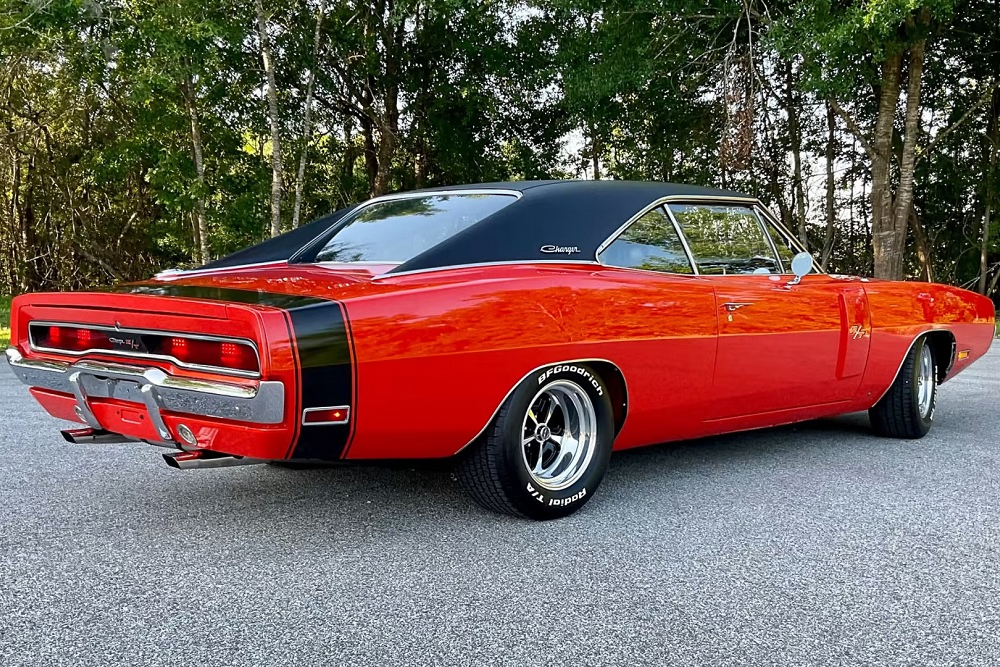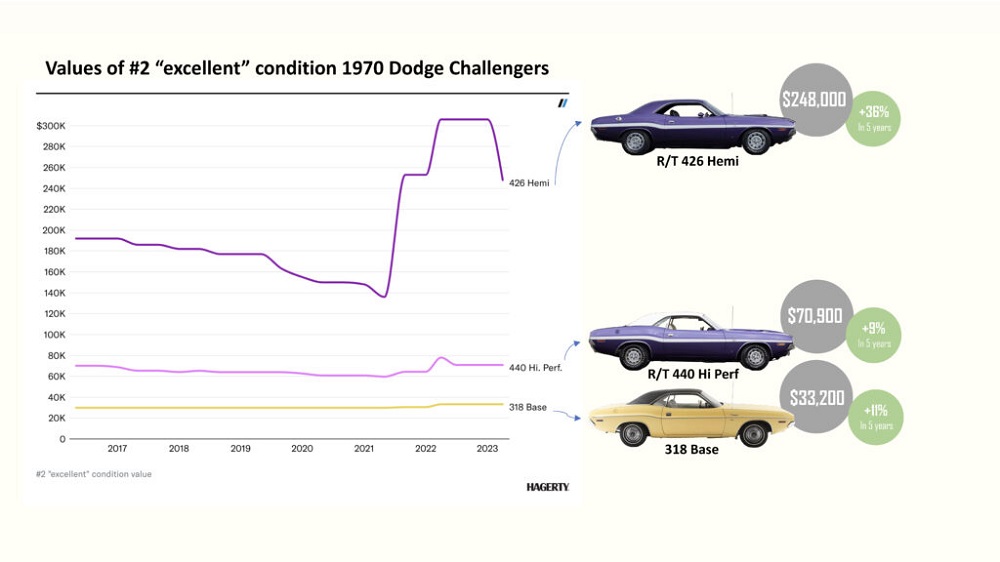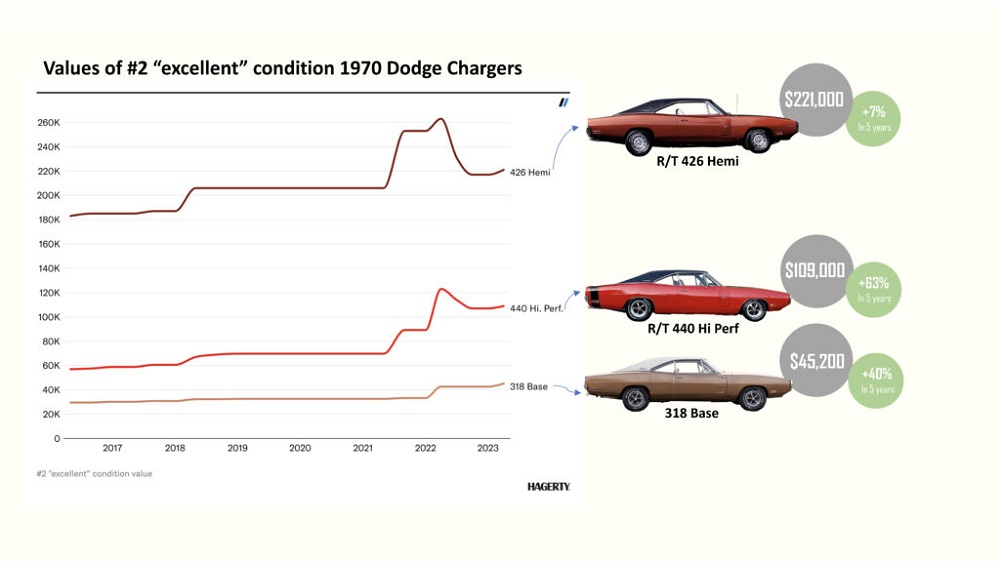If you’ve ever paid any attention to the auction broadcasts that show numbers-matching, perfectly restored muscle cars crossing the well-lit block before an ogling crowd, you might think that gorgeous ’60s and ’70s sheet metal is out of your reach.

It’s true that the most desirable examples, typically the rarest and most powerful, bring eye-watering prices, which is also why they garner the most headlines and hype.
However, there are still plenty of curvaceous coupes that deliver all the style and V-8 soundtrack at attainable prices. If you’re willing to opt for a small-block and add a four-barrel carburetor on your own, you’ll find that prices on some of Mopar’s most beautiful creations are surprisingly reasonable. In fact, some of the most tempting value propositions are found within Dodge’s most recognizable classic muscle cars—the 1970 Challenger and 1970 Charger.

Introduced in the fall of 1969, the 1970 Challenger was the Dodge’s long overdue answer to the Ford Mustang and Chevrolet Camaro in the pony car wars. The Plymouth equivalent was the third-gen Barracuda. Options were numerous and eight engines were available, from a humble slant-six to the range-topping 426 Hemi. Dodge also offered 22 paint colors, many of them bright “high impact” shades like Panther Pink and Top Banana, to distinguish the Challenger from its more established competition. About 83,000 were sold.
As for the Charger, it had been around since 1966 but matured for 1968 with a crisp Coke-bottle redesign made famous in the Bullitt chase scene and on The Dukes of Hazzard. As the big news for 1970 was the Challenger, Dodge mostly left the ’70 Charger alone except for a few details, the most noticeable being a loop front bumper around a one-piece grille. Like the Challenger, engines ranged from small slant-six to monster V-8, and total production was nearly 50,000.

The 1970 model year was the first for the new Challenger and last for the second-gen Charger, but from 1971 on both models started to lose their good looks and unencumbered horsepower. The style and speed of the ’70 models make them some of the most popular vintage muscle cars around. Their wide range of engines and options, meanwhile, allows for a huge spread in terms of price.
Now, then, let’s look at some data on these icons of Mopar muscle. The models that garner the most attention and biggest bucks are, in the Charger’s case, the NASCAR homologation Daytonas, sculpted and winged for 200-mph superspeedways. But the magic word for either Charger or Challenger is “Hemi.” These days, it seems that Mopar has had no problem selling 11,000 Hemis in a week, but the Gen II 426 Street Hemi of old sold about that many in its entire six-year production run (1966–71). A real 426 Hemi car is a rare and welcomed sight at any car show. With rarity, range-topping status, and serious racing credibility, they demand a serious premium.
Though several engine and trim options exist, we focused on two to illustrate accessible Mopar entry points. For those in the market for a weekend driver with the same gorgeous lines and many of the same options as those rare Hemi machines, the 318- and 440-powered models are still out there, in greater numbers, and at much more affordable prices.

The 2-barrel, 318-powered Challenger and Charger have seen a similar uptick in value as the 375-hp 440 has, but not nearly as large as that of the 426-powered cars. We’re used to seeing rising prices of the most desirable trims and engines lead to rising prices across the model range. Typically, and as is the case with the Challenger, the more affordable models often see a less substantial increase. The curvaceous lines of Mopar’s quintessential muscle car are favored over the Challenger, although five years ago their prices were virtually dead even. Cars in #3 (Good) condition offer even more compelling value, with the Charger R/T 440 and base 318 coming in at $71,500 and $30,500, respectively. The Challenger follows suit, at $46,300 for the R/T 440 and a $21,100 for the base 318.

As far as demographics, Gen X makes up a disproportionate share of quotes sought for the Charger, at 39 percent, while the cohort holds 32 percent of the overall collector car market. Those interested in the Challenger, on the other hand, skew a bit older, with baby boomers coming in at 44 percent of the Challenger market compared to their 34 percent share of the overall collector market. The interest among younger buyers suggests that Charger values may have a slightly stronger future than those of the Challenger, but the difference between the two is not dramatic.
If you’re in the market for one of these attainable two-doors, we must admit that a 2-barrel 318 isn’t the most exciting power plant. But if numbers-matching isn’t your thing, it’s never been easier to build a powerful yet streetable Mopar small-block or swap in a late-model Hemi. And even if numbers-matching is your thing, that correct engine won’t mind if it sits on a stand while a rowdy 408 gets out to play on the weekend. It’s a well-known fact that even a mild, rebuilt 318 Charger or Challenger that gets driven sounds better, is more fun, and garners much more attention than a 426 Hemi that never leaves the garage.
Report by Brandan Gillogly
find more investment guides here…










